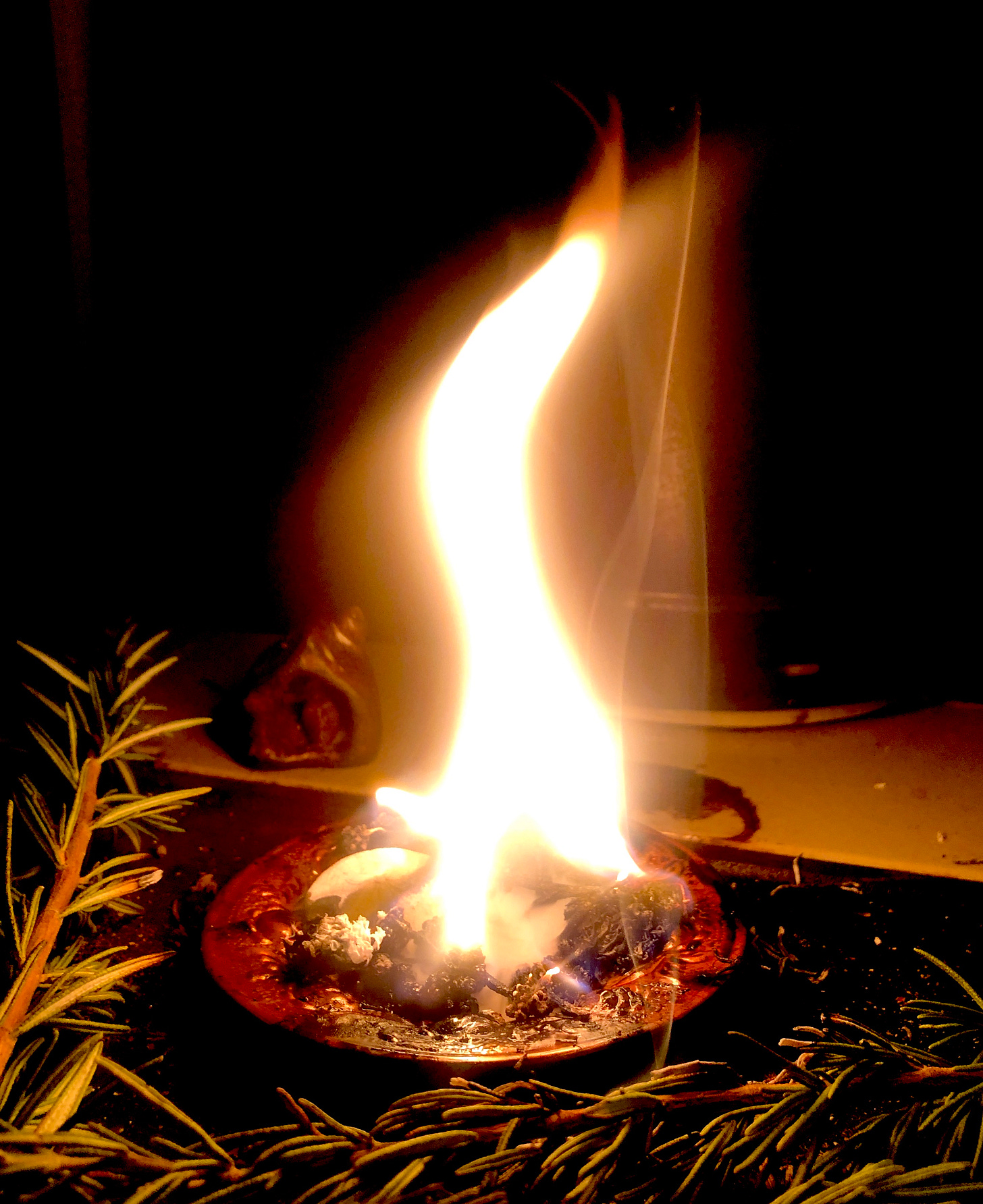On the final night of filming, after four weeks straight of dizzying amounts of work, just as I finished the 7th lecture, my candle melted down to its root and caught the resinous flowers gathered around it (pearly everlasting, from two summers ago) on fire.
Suddenly I had a beacon on my hands. A torch in a tiny bronze dish. It felt like a flame right out of the Baba Yaga’s hut, like the one Vasilisa carries back in a skull after much hard work and more than a little terror. It felt like a lick of flame from the vestal fire that the mothers of Rome made pilgrimage to barefoot every year at the summer solstice, even through the centuries of empire.
It did not feel quite of this world.
I started at it stupidly for a very long moment, as it lapped at the air next to my computer and camera-stand and stacks of books. I blew on it, also rather stupidly. It got bigger. I was absolutely mesmerized. It didn’t occur to me, to be honest, to just dump some water on it— it felt too holy. It was Hestia herself. I wanted to watch her. And I knew the flame was contained well enough in its little dish, though leaping, as long as I kept my eye on it.
So I managed to fumble it across the room to the top of the woodstove, spilling wax as I went. When I moved too fast the flame surged quick as water over my hands—so quick it didn’t burn. This was also mesmerizing. I moved very slowly. I finally got it to the top of the woodstove, panting a little.
Then I turned off all the lights, and just sat with the flame as it leapt and licked and danced, feeling the immensity of the seven storied threads I’d finally brought through over the span of a single moon cycle. Motherhouse. Vestal Hearth. Bear-Woman. Holy Water. Swanskin. Tree of Life. Spindlewhorl. The fire licked and coiled and seemed to cure them, somehow, in my psyche. Like hides getting smoked in the smokehouse.
After a while— maybe half an hour, but in otherworld time a whole season, the entire migration of a pair of mated swans through the northern night sky— the flame tucked herself away into the ashes. She went back through the portal to the fireplace where one of my ancestors was probably poking embers and laughing to herself about the fright—and also delight—she’d given me.
I would later put the ashes over the saffron bulbs planted at the top of the garden. Mystery ember offered to mystery crocus, in the old way of midwives.
These seven lectures, these seven threads that I’m speaking of, are the seven facets of my online course When Women Were the Land: Unearthing the Myths & Histories of Old Europe which is being offered through Advaya. The live version of this course runs from December 9th through January 20th—but access to the material is ongoing if you can’t make those dates.
I’m beyond honored, and deeply excited, to be sharing this material in this way with all of you. And I would love love love to see you there.
In these lectures, I’ve gathered together the passion, research, knowledge and devotion of the past seven years of my work— and really of my whole lifetime, honestly, since I was a young girl reading every version of the Six Swans fairytale she could find, memorizing the names and attributes of ancient Mediterranean deities, and talking to the rose bushes and the apple tree in my mother’s garden.
Each lecture includes a telling of a myth or fairytale (there’s Vasilisa the Fair; the story of Calypso from the Odyssey and Tethys goddess of underworld waters; the White Bear King Valemon; Cinderella; and more), woven through with lines of archaeological and historical information that root us right far back in the non-patriarchal Neolithic and Paleolithic of Europe. To a time in my ancestry when the earth, the mothers, and the children were honored, respected, and treated with dignity. Each lecture also includes a guided visualization and accompanying creative prompt, so that the threads of story and history that we explore each week can nestle and root deep into your own embodied experience and be expressed both creatively, and through nature-connection practice.
As a woman of mixed European ancestry born and raised on Coast Miwok land in California, with a motherline that reaches back to the Puritans in Massachussetts, and before that to Yorkshire in the north east of England, and long, long before that to the Neolithic Balkans (according to my mitochondrial DNA results!), the question of belonging has always been a challenging and poignant one for me personally—because my more recent ancestry carries responsibility for the violent colonization and displacement of the indigenous people of Turtle Island, and my further-back ancestry winds its way through some pretty harrowing centuries in England. Centuries of plague, land enclosures, witch burnings, and the intense violence of the Protestant Reformation, which stripped so many churches of the last traces of pagan folk practices and connection to the land, and of the feminine divine in the form of the Virgin Mary.
It's been a very long time since the women of my motherline were rooted in a healthy and whole way in an ancestral land, and so there’s a big wound there. The kind of wound that crosses the sea and tries to settle on other people’s land to fill the empty place, the desperation, that’s been there so long we’ve forgotten its origin.
This course is my attempt to address this wound, and offer an outpouring of medicinal honey back.
I don’t know precisely how far or precisely where I have to go to find the time when my female ancestors lived peacefully and deep-rooted in place, but what I do know is that I can gather pot shards and traces in archaeological reports from the Neolithic in the lands of my far-back ancestors, and I can dig deep under the surface of European myths and fairytales to look for motherline threads, threads that point to traditions passed down woman to woman.
What I do know is that the Earth loves each of us, and is there for each of us as a Mother, to teach us everything that we have forgotten, if we just slow down and listen to the animals and plants and waters where we are. And I believe that in doing all of this, I can fill that hungry place with real, soul nourishment, so that I don’t continue to pass on the undigested trauma of my ancestors, but rather stand with those who have been the recipients of it, and with the Earth.
And so I hope that my course, When Women Were the Land, will bring each of you this storied, myth-threaded nourishment and this feeling of a deeper belonging as a daughter of this Earth and a sister of all women around the world.
Read below for descriptions of what we will talk about in each of the seven lectures — and remember that if you register for the live course from December 9th- January 20th, you’ll have access to weekly live Q & A conversations with me and other students about what we have covered each week.
All the way at the end of the page is a discount code, just for you my dear readers!
* top image: an illustration from Die Goldene Frau, The Golden Woman (1972), the German edition of a collection of Slovakian folktales gathered by Samo Czambel and illustrated by Viera Bombováon

Really, it’s a gathering of threads. Seven threads to follow to the Motherhouse and back again.
One thread all of embers from the Etruscan hearthfires of long ago Vestal Virgins.
One thread of pure bear-fur gathered off the thorn bushes, fur as dark and musky as childbirth.
One thread of shining water twisted up from the underground springs of Tethys which are also the waters of the Danube which are also the waters of the Seine which are also the waters of the Otherworld.
One thread of white feathers from migrating birds who are sometimes women: storks, swans, snow geese.
One thread of the bark of the linden tree at the center of the world where the fates make divinations by the leaves and the roots about death and birth.
One thread of all the stories women sang at their looms to each other and the children for three thousand years while bards sang in the halls of kings about the feats of heroes.
And one thread that is you….
Week 1: Motherhouse - introduction to the ground and the field
In this opening lecture we will discuss the concept of a pre-patriarchal, matrifocal “Old Europe,” both through the work of Marija Gimbutas and the lineage of scholars who came before her, especially women, like classicist Jane Ellen Harrison. We will talk about what I mean by the term “motherhouse”— connected to the Neolithic sites across the Balkans as well as Çatalhöyük in present-day Turkey, where the bones of generations of ancestral women were very often buried in the walls, beneath the threshold or under the oven. The house was very literally the body of collective ancestral mothers, a place where all you needed to do was touch the wall or the floor or the warmth of the hearth to feel them near. What would it feel like to remember the motherhouse in each of us? We will explore the Greek myth of Europa, namesake of Europe, and her journey from Anatolia to Crete as a map of early migrations and the meeting of Neolithic and Mesolithic cultures. We will look at matrilineal house-structures in early Bronze Age Crete, and examine the myth of Demeter and Persephone as a memory-holder of matrilineal consciousness before the dominance of Myceneaen war-gods like Zeus. And we will ground ourselves in our own motherhouses through creative practice and connection to the earth where we each are.
Week 2: Hestia - original languages of worship
At the heart of the cave, there is a fire that never goes out. This is the fire in your motherhouse. In ancient Greek, the word εστία literally means the home and the hearth. The home as hearth. It is also the name of a goddess, but in the ancient Greek conception it means home and hearth first. Then the goddess. The goddess is these. She is inseparable. The home is the place where the wildest force of all — fire— is kept and tended. In this lecture, I will tell you the Russian story of Vasilisa who went to get fire from the Baba Yaga’s hut, and how this journey and the features of this fairytale might have Old European roots. We will explore the Vestal Virgins of ancient Rome and the ritual relighting of fires across the city by the mothers, as well as the offerings traditionally given to the fire both in ancient Rome and all the way across Europe, in Lithuania— and what all of this might have to do with early traces of temples and hearth-worship in the Neolithic and before.
Week 3: Bear Woman – mistress of animals, keeper of herbs
The oldest of temples was the cave, where women once married bears, and gave birth to both human babies and bear cubs. In this second module we look at Paleolithic cave paintings from France; at ancient rituals surrounding the bear hunt; at variants of “The Woman Who Married a Bear” myth and its traces in the Norwegian fairytale “East of the Sun, West of the Moon,” and the story of the birth of Otso the bear in the Finnish Kalevala, as well as concepts of female guardians of the forest and its animals. We discuss the bear as original herbalist and teacher of plant medicine to human beings, and the womanhood initiation traditions surrounding Artemis Brauronia in classical Greece.
Week 4: Holy Water – renewing what is sacred
In pre-Hellenic Greece, there is a goddess named Tethys. She is the mother of ten-thousand sea and river nymphs, wife of the god Okeanos, and the keeper of the primordial font of spring water that emerges from under the ground to nourish the earth. Her name is connected to ancient Greek words for both grandmother and nurse. Wherever there are water nymphs, maidens who guard wells and freshwater springs, or sacred caves now dedicated to the Virgin Mary where unending spring water still flows, we are in the presence of Old European memories of the water of life, the grandmother of us all. We will discuss Calypso on her island in the Odyssey, the sacred Otherworld waters and wells and sacred rivers in the Celtic tradition and their connection to goddesses of sovereignty, including a look at Grail legends and the Wasteland. We will connect with the local waters where we each live, and to the imaginal waters of our foremothers.
Week 5: Swanskin – flying through seasons, to the stars and back
Figurines with women’s bodies and the masks of birds abound across Neolithic Europe, especially amongst the Vinča culture, where figures depict bird-masked dancers, priestesses or shamans. Are they enacting rituals of seasonal return, or visionary, oracular flight? On Minoan sealstones from a thousand years later, pregnant women with bird wings squat in birthing postures, or leap into flight. Homeric epics, with their descriptions of the cosmic songs of the Sirens, gesture toward a language of the wild earth and of the bird-sung sky that long precedes the bard. And across Europe, especially in the north and east, migratory swans transform in folktales and myths into women and back into swans, marking the cycles of the seasons and often bringing both vision, and love, to human men. In this module, we will look at a Lithuanian fairytale about a swan mother, as well as the traces of swanskin and stork-mother myths across eastern and central Europe, concluding with a conversation about bird-language as a font of ecological knowledge.
Week 6: Trees of Life – rooting into earth and birth
The concept of a sacred tree that reaches from the depths of the earth to the celestial realms, or bears the fruit of eternal life or blessing, can be found all over the world. Before the garden of Eden there was Asherah, Canaanite mother goddess who was worshipped in the form of a tree. Before the garden of Eden, countless tiny sealstones from Minoan Crete depict worshippers communing with fruit-bearing trees. Greek myths tell of women transforming into trees, sacred orchards, and oracles, while Norse mythology has the world-tree Yggdrasil, with the Norns weaving fate beneath its roots. Further back, in the Neolithic of Old Europe, we see a root system of thinking that connects the ancestral dead to the yet-to-be-born future generations, through the medium of the sacred tree, and a special connection between motherhood and an arboreal goddess. In this lecture, we will take a close look at the Grimms’ version of Cinderella, to study the mother-tree at the center of the story. We will look at traditions surrounding the burial of the placenta after childbirth, and how communication with trees is a communication with both the past and the future.
Week 7: Spindlewhorl - following our motherlines home
One of the most common ritual offerings found across Neolithic Europe are spindlewhorls— the round weights at the bottom of spindles, which were used to handspin raw fibers into thread. In this module, we will bring together all the threads of the past six weeks through the lens of the powerful connection between textile work and women’s storytelling traditions. We will look at examples of women weaving and tale-telling across Europe, from Penelope at her loom in the Odyssey to the old “wives” and “gossips” said to be at the heart of the fairytale tradition in the 1600’s, and beyond. We will reclaim the ball of thread that Cretan Ariadne gave to Theseus to find his way in and out of the labyrinth in order to kill the Minotaur, and also discuss how this story has echoes all throughout the folktales of Europe, where old wise grandmothers give young heroines and heroes balls of wool to follow “across thrice-nine mountains” in order to find their heart’s desire. We will spin together the threads of hearths, holy waters, bear-women, swanskins, and trees of life from our time together, and see what new tapestries our motherlines are asking us to weave now. Where and how will we offer what we have made?

















What an absolutely mystical and magical flame presence and the timing of which sounds very powerful and meaningful indeed!
I’m so excited for your course and looking forward to delving deep into it all! I do hope to join the live conversations as well. Thank you for this beautiful and abundantly overflowing offering! I can’t wait! xox
Such wonders, Sylvia. Don't think I'll take this course but I wanted to offer my blessings to it. I'm just sad and afraid and crying all the time these days. This recent American election isn't about what it's about on the surface- I believe it's about an old patriarchal fear of losing control, and so a rather patriarchal shadow has been roaring across the world in figures like Putin and Bolsanaro and Orban and Trump and so many guys in Africa with guns. Dangerous men with guns, actually scared boys afraid what will happen if they put down their clubs. And it feels like it's going to get a lot worse before it gets any better. Oh Lord why us why now?
You are the hope. Your work is acting as a light to the world. An ongoing Resurrection. It will feed life. Life will return. And for those folks who think most men love what's happening to the Earth and to women these days, let me speak up for us who would rather be the guardians of the red tent and not the ones destroying it. I don't vote for these overgrown middle school bully boys..... but just like in 8th grade they seem to offer a "poisoned thread" that has appeal.
Your work offers the thread of medicine and healing. God love you. You bring smiles to my many tears.